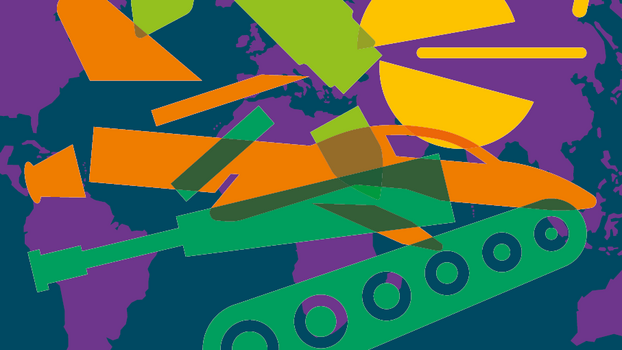Facts and figures against the wars of today and tomorrow
Book
Eva Wuchold
PUBLISHED
April 2024
https://www.rosalux.de/
Related Files The Atlas of Disarmament

Peacemaking victories were always hard-won. We were reminded of this by UN Secretary-General António Guterres at the Geneva Conference on Disarmament in February 2024. The victories were not miracles, either. Guterres went on to say they were achieved because the opposing states recognized that the key to disarmament lies in cooperation for mutual benefit — and not in competition for mutual destruction. Moreover, military spending ties up valuable financial resources that are no longer available for important social causes such as health, education, and infrastructure, or for solving global humanitarian challenges such as climate change and climate adaptation.
With the new Atlas of Disarmament, the Rosa Luxemburg Foundation aims to use country studies, thematic articles, and graphic illustrations to show the opportunities and possibilities that lie in global disarmament.
Disarmament efforts aim to reduce military activities that cause considerable environmental and climate damage and to reallocate military resources to sustainable development initiatives. By channeling military resources into programmes to combat poverty, hunger, and social inequality, these resources would promote economic justice and equitable development and thus serve to prevent conflict.
While many countries are currently opting for armament rather than disarmament, the case studies in the atlas show that even in recent years, countries such as Colombia and Nigeria have opted for demilitarization in order to resolve conflicts. There are success stories of civil society involvement, such as the landmine campaign, the treaty banning nuclear weapons, or the Group for a Switzerland without an Army. We also have successful treaty negotiations at international and multilateral level that have continued even after the invasion of Ukraine by Russian troops, such as the Global Declaration on Explosive Weapons or the Global Framework on Conventional Ammunition.
All of this shows that we are not starting from scratch when it comes to disarmament. There are bodies and institutions that support global peace, security, and disarmament systems — from the United Nations to the Geneva Conference on Disarmament. There are government agencies, intergovernmental organizations, non-governmental organizations, and bodies such as the OSCE that deal with arms control. And there are agreements and treaties, such as the Treaty on the Prohibition of Nuclear Weapons, which are valid and must finally be implemented.
Above all, however, there are good reasons for disarmament, especially in times of war and crisis. Experience in recent years has shown that the need to resolve tensions through political dialogue and negotiations is becoming increasingly urgent.
Download PDF
Here you can download the illustrations used in the atlas bundled in different formats. This work is licensed under the Creative Commons Attribution 4.0 International Public License (CC BY 4.0). You may use the individual infographics in this atlas for your own purposes provided that the copyright notice “Bartz/Stockmar, CC BY 4.0” is placed near the graphic. When editing the graphics, please note “Bartz/Stockmar (M), CC BY 4.0”.
Download ZIP
No comments:
Post a Comment